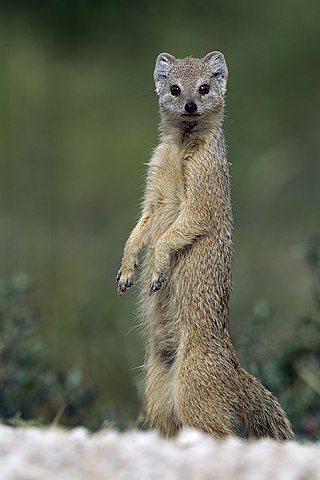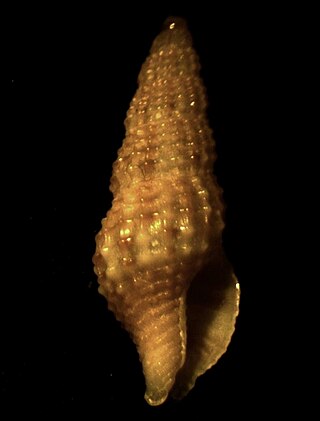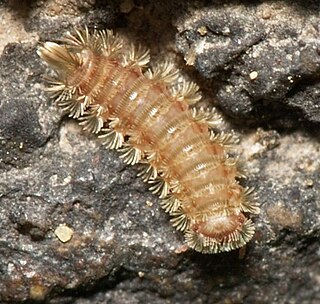
Beroidae is a family of ctenophores or comb jellies more commonly referred to as the beroids. It is the only family within the monotypic order Beroida and the class Nuda. They are distinguished from other comb jellies by the complete absence of tentacles, in both juvenile and adult stages. Species of the family Beroidae are found in all the world's oceans and seas and are free-swimmers that form part of the plankton.

The black-tufted marmoset, also known as Mico-estrela in Portuguese, is a species of New World monkey that lives primarily in the Neo-tropical gallery forests of the Brazilian Central Plateau. It ranges from Bahia to Paraná, and as far inland as Goiás, between 14 and 25 degrees south of the equator, and can commonly be seen in the City of Rio de Janeiro where it was introduced. This marmoset typically resides in rainforests, living an arboreal life high in the trees, but below the canopy. They are only rarely spotted near the ground.

The woylie or brush-tailed bettong is a small, critically endangered, gerbil-like mammal native to forests and shrubland of Australia. A member of the rat-kangaroo family (Potoroidae), it moves by hopping and is active at night, digging for fungi to eat. It is also a marsupial and carries its young in a pouch. Once widespread, the woylie mostly died out from habitat loss and introduced predators such as foxes. It is currently restricted to two small areas in Western Australia. There are two subspecies: B. p. ogilbyi in the west, and the now-extinct B. p. penicillata in the southeast.

The yellow mongoose, sometimes referred to as the red meerkat, is a member of the mongoose family. It averages about 0.45 kg (1 lb) in weight and about 510 mm (20 in) in length. It lives in open country, semi-desert scrubland and grasslands in Angola, Botswana, South Africa, Namibia, and Zimbabwe. It is the only species in the genus Cynictis.

Banksia penicillata is a species of shrub that is endemic to a restricted area of New South Wales. It has smooth bark, serrated, elliptic to egg-shaped leaves, green to bluish flower buds, later yellow flowers in a cylindrical spike, and later still, up to one hundred narrow elliptical follicles in each spike, surrounded by the remains of the flowers.

Bettongs, species of the genus Bettongia, are potoroine marsupials once common in Australia. They are important ecosystem engineers displaced during the colonisation of the continent, and are vulnerable to threatening factors such as altered fire regimes, land clearing, pastoralism and introduced predatory species such as the fox and cat.

The grey-headed tanager is a widely distributed species of small Neotropical bird in the tanager family Thraupidae. It is the only member of the genus Eucometis.

Pseudomelatoma is a genus of predatory sea snails, marine gastropod mollusks in the family Pseudomelatomidae.
Pseudomelatoma penicillata, common name the doleful turrid, is a species of small sea snail, a marine gastropod mollusk in the family Pseudomelatomidae.

Hastula penicillata is a species of sea snail, a marine gastropod mollusc in the family Terebridae, the auger snails.

Hastula is a genus of sea snails, marine gastropod mollusks in the family Terebridae, the auger snails.

Nassarina is a genus of sea snails, marine gastropod mollusks in the family Columbellidae, the dove snails.
Echinolittorina penicillata is a species of sea snail, a marine gastropod mollusk in the family Littorinidae, the winkles or periwinkles.

Beroe, commonly known as the cigar comb jellies, is a genus of comb jellies in the family Beroidae. Beroe exhibits bioluminescence.

Polyxenida is an order of millipedes readily distinguished by a unique body plan consisting of a soft, non-calcified body ornamented with tufts of bristles – traits that have inspired the common names "bristly millipedes" or "pincushion millipedes". There are at least 86 species in four families worldwide, and are the only living members of the subclass Penicillata.

Beroe ovata is a comb jelly in the family Beroidae. It is found in the South Atlantic Ocean and the Mediterranean Sea and has been introduced into the Black Sea, the Aegean Sea, the Sea of Azov and the Caspian Sea. It was first described by the French physician and zoologist Jean Guillaume Bruguière in 1789.

Beroe cucumis is a species of comb jelly in the family Beroidae. It is found in the Atlantic Ocean. It was first described by the Danish missionary and naturalist Otto Fabricius in 1780.

Caldoramide is a pentapeptide isolated from the cyanobacteria Caldora penicillata. It has cytotoxic effects on cancer cells and has been the subject of extensive oncological research. It is structurally analogous to belamide A and dolastatin 15. Its appearance is that of a powdery, white, substance.
Beroe gracilis is a species of comb jelly in the family Beroidae. It is a free-swimming species found in the North Sea, the Atlantic Ocean and the Mediterranean Sea.

Wrangelia is a genus of red algae in the family Wrangeliaceae.
















